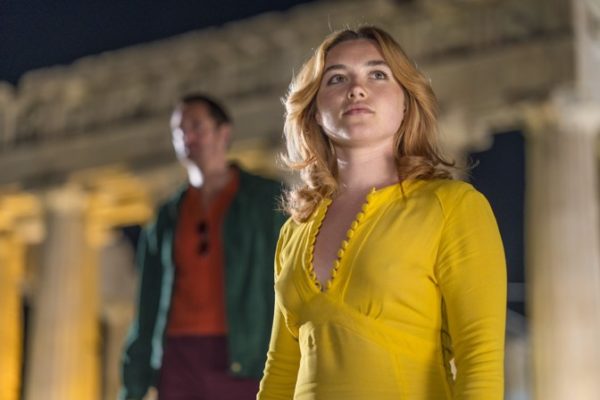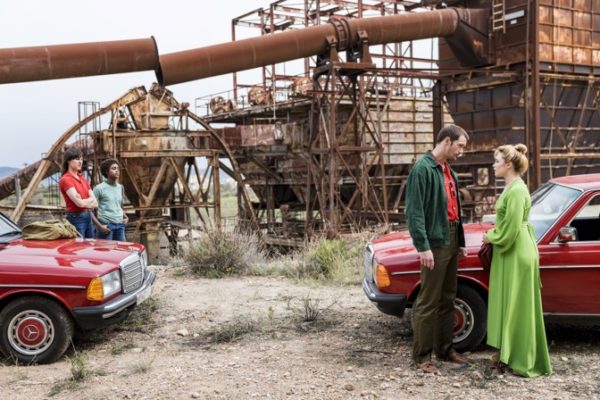The Ravishing Way Park Chan-wook Uses Color in The Little Drummer Girl
The director explains the symbolism behind the AMC miniseries’ vivid palette.
The realm of espionage isn’t typically associated with color. Clandestine operatives work in the shadows, fading into the background by necessity. But in The Little Drummer Girl, a new miniseries based on the 1983 novel by John le Carré, the elaborate subterfuges of the spies—and their plot to infiltrate a Palestinian terror cell by passing off a young British actor as a sympathizer of their cause—depend on being seen. So that actor, Charlie (Florence Pugh), meets her handler at the Acropolis wearing a dazzling canary-yellow dress. Smugglers sneak explosives across international borders wearing traffic-light colors, vivid shades of red and green.

The vibrant palette selected by the South Korean auteur Park Chan-wook (Stoker, The Handmaiden) for his first foray into television serves a variety of purposes. Park, who before he was a filmmaker wanted to be an art critic, has a painterly eye for chiaroscuro, casting elements and characters in his work into sharp contrast using light and shade. With The Little Drummer Girl, he wanted to take things a step further, differentiating the look of the show from his previous work, and from other movies in the espionage genre. In his films, he told me via a translator during an interview in an editing suite in London, primary colors are used sparingly, as accents in otherwise calm environments. But in The Little Drummer Girl, color is front and center. “It’s actually more beneficial,” Park said, “for these characters to be noticed and to be witnessed in the fiction they’re creating.”
Park’s bold hues also hint at the knotty politics of The Little Drummer Girl, where no one is, or can afford to be, neutral. The six-part AMC series, which concludes its three-night run on Wednesday, is set during the 1970s. Its fiendishly complicated plot imagines an Israeli effort to infiltrate a Palestinian terrorist cell, using Pugh’s Charlie as bait. The Israeli spymaster Martin Kurtz (Michael Shannon) tells her she will be participating in an immersive acting project called “the Theatre of the Real.” She’s seduced into joining his mission by Gadi Becker (Alexander Skarsgård), an Israeli agent who uses method-acting techniques to pull Charlie further into the invented reality that Kurtz has created.

As The Little Drummer Girl plays out, it seems to comment on the murky and complex morality of both international espionage and acting itself. Park felt an affinity with Kurtz, writing a line for him in which the spymaster tells Charlie, “I am the producer, writer, and director of our little show.” Becker, who stays in character as the terrorist “Michel” during most of his interactions with Charlie, contributes to her increasingly frayed sense of what’s real and what’s a lie. But Kurtz, as the overseer of the intricate operation, is running the show, which turns The Little Drummer Girl into something of an allegory for the art of filmmaking. Park emphasized—with a smile—that he’s by no means as manipulative as Kurtz. But Park said he related to him, as a creator of fantasies that pull in both the actors and the audience.
In the series, when Charlie first encounters Becker, she’s in Greece as part of a performing theater troupe. In these scenes, the two characters switch between wearing orange and blue, complementary colors that tie them together and immerse them in the surrounding shades of the Mediterranean backdrop. But later in Athens, when Charlie learns the truth about why Becker has brought her to the city, she’s in yellow, and he’s in red and green, in character as Michel. The clashing tones symbolize the increasing discordance in Charlie’s mind.

The colors help emphasize one of the themes Park most wanted to bring out in the series, which is the idea of duality. Becker is both himself and Michel; Charlie is an actor who’s increasingly becoming the character she’s been enticed to play. The plot of The Little Drummer Girl, which considers age-old hostilities in the Middle East, is all about forces in conflict with each other. There’s the dynamic, Park said, between fiction and reality, and how the lines get blurred. Then there’s the question of “what’s the truth and what’s performance. And also the dynamic between the assailants and the victims.”
The aesthetic qualities of the 1970s also define the visual qualities of the show, although certain characters get to transcend them. During the ’70s, Park was growing up in South Korea, which he described as “quite dark and very repressed” compared with Europe during the same moment. So being able to use bold colors to portray the period, he said, “was something that was very exciting to do.” In scenes set in Munich and London, bold geometric prints and tweedy polyester in shades of orange and brown add visual texture to their environments, anchoring the spycraft as a product of its era. But the characters of Charlie and Becker are distinguished by much brighter hues, adding a sense of heightened surreality to proceedings.
For Park, The Little Drummer Girl represented an opportunity to adapt a work by an author he’s long been a fan of. “After seeing the [2011] adaptation of Tinker Tailor Soldier Spy,” he said, “I was so envious of Tomas Alfredson, and thinking that I should have been the one to adapt that novel into a film.” Drummer Girl, an AMC/BBC co-production, comes on the heels of The Night Manager, another le Carré adaptation (directed by Susanne Bier) that received extravagant critical acclaim for its lush, cinematic vistas and its ethically ambiguous characters. The complexity of le Carré’s books is a challenge for film directors, who have to drastically trim his plots down to size. Television seems to be a more natural fit, although even six episodes, Park notes, didn’t feel like enough time to tell his story.